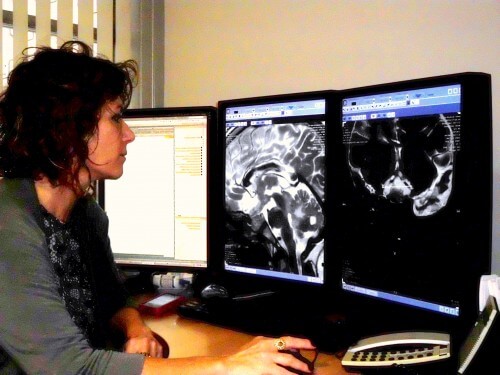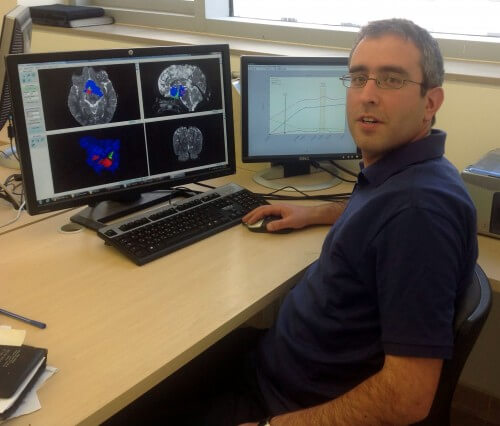Collaboration between researchers at the Hebrew University and the Ichilov Hospital led to the development of a new method for detecting the spread of tumors

New research improves the way decisions are made in the treatment of cancerous tumors. Also, the research sheds light on the effectiveness of the treatment in many cases where the treatment was considered ineffective in the past.
Assessment of the spread of cancer tumors during treatment, and especially brain tumors in children, is mainly based on MRI scans performed on the patient before and during treatment. Today, in light of the shortage of time and manpower in the hospital, this assessment is carried out with a rough and one-dimensional estimate of the spread of the tumor in the MRI imaging over time. This estimate is extremely simplistic and does not take into account volumetric changes in the tumor and/or internal changes in the components of the tumor. Therefore, sometimes he even misleads the medical team when it comes to making fateful decisions concerning the continuation of the treatment.
New research improves this assessment ability by tens of thousands. The research, which has developed into an innovative system of its kind in Israel, performs volumetric, rare and reliable quantification of the tumor in the patient's MRI imaging over time. In addition, the system even provides the treatment team with an internal analysis of the various components of the tumor, thus shedding light on the effectiveness of the treatment in many cases that in the recent past were mistakenly considered unsuccessful.
The research, which was carried out under the auspices of the Kamin program (promotion of selected applied research) of the Ministry of Science and Technology, is the result of a collaboration between Dr. Lior Weizman and Prof. Leo Youskowitz from the School of Engineering and Computer Science at the Hebrew University and the team from the Sourasky Medical Center (Ichilov) in Tel Aviv which included: Prof. Shlomi Constantine and Dr. Ben Shofti from the pediatric neurosurgery department and the Israel Gilbert Neurofibromatosis Center, Dr. Liat Ben Sira and Dr. Li-Tal Pert from the pediatric imaging department, and Dr. Dafna Ben Beshat from the Wahl Center for Brain Imaging.
Dr. Lior Weizman, who developed the system as a central pillar of his doctoral research, explains: "Already at the beginning of the research, it became clear that quantifying the volume of the cancerous tumor at a single point in time is almost meaningless in the decision-making process. The most important factor is the nature of the change in tumor volume between two consecutive MRI scans. In light of this, we developed an innovative image processing algorithm for MRI imaging which focuses on producing the quantification of the volumes of the spleen and is consistent for each subject participating in the study."

"After examining the performance and success at the research level, we developed a system that applies the pure academic research to practical application, with the full cooperation of the medical team. This was done while emphasizing the intensive nature of the work in the hospital in Israel, which requires an automatic and independent system as much as possible on the one hand, while not compromising on reliability on the other hand. To my delight, the system works flawlessly and is a leap forward in the way of assessing the spread of cancerous tumors in the hospital" concludes Dr. Weizman.
The innovative system, which has been active in the hospital for about a year, is innovative of its kind in a hospital in Israel. It is fully active and produces a reliable and accurate quantitative assessment of tumor spread in oncology patients, for the purpose of improving the way decisions are made in these patients. The system has been presented at many international conferences, such as the ISBI conference of the IEEE community and the EANS conference of the neurosurgical community. An academic article describing the research and its implications was recently published in the prestigious journal Medical Image Analysis.

With the help of this tool, the researchers recently identified a subgroup of children with brain tumors that respond better to chemotherapy, which makes it possible to optimize the administration of treatment and avoid unnecessary administration of chemotherapy to children unnecessarily.
Dr. Lior Weizman obtained a bachelor's and master's degree in electrical engineering from Ben Gurion University of the Negev, a third degree from the Hebrew University and is currently a post-doctoral fellow in the Technion's Faculty of Electrical Engineering.

2 תגובות
Well done!
The use of MRI in brain research and brain diseases must continue to be expanded.
In my opinion, the field of psychiatry should be promoted by using MRI.
It is also time to stop calling them "mental illnesses" and start treating them as brain diseases.